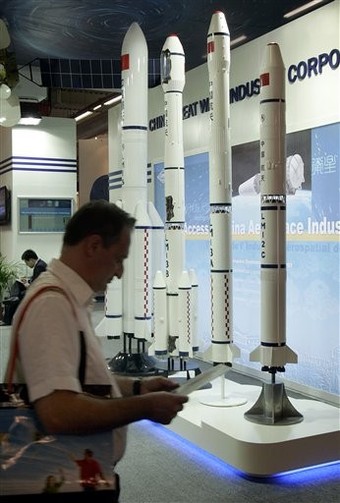
Advances in China – Latin America Space Cooperation
Publication: China Brief Volume: 10 Issue: 14

In China’s first white paper on the country’s relationship with Latin America released in November 2008, the only reference to cooperation on space issues accounts for a portion of one sentence within the long document: “The Chinese side will also strengthen cooperation with Latin America and the Caribbean in aeronautics and astronautics … and other areas of shared interest” (People’s Daily Online, November 6, 2008). Yet, just one month before the Chinese government released the white paper, China Great Wall Industries Corporation (CGWIC) launched into orbit the first wholly indigenous-built satellite for a Latin American customer. In the four years since 2006, China has made major inroads in space cooperation with Latin America, launching its third satellite in a collaborative venture with Brazil, launching a wholly Chinese-built telecommunications satellite for Venezuela, contracting with Bolivia for a similar satellite, launching a new Beijing-based regional space cooperation organization that includes Peru, and pursuing significant space-related projects in Argentina and Chile. As these examples suggest, advancement in China-Latin America space cooperation is occurring, although largely out of the public eye, and is important, following a pattern shaped by the varied interests and space-related capabilities of Latin American states, as well as the growing ideological divisions in the region.
For the PRC, space-related initiatives in Latin America are oriented to support the development of this strategically important sector while strengthening partnerships with countries that it regards as important. This paper focuses on three categories of Latin American countries with which the PRC has space-related interactions: (1) populist regimes acquiring satellites, (2) other countries developing limited space capabilities, and (3) Brazil as an emerging regional power with a multidimensional space program.
Populist Regimes Purchasing Chinese Satellite Systems
China’s most significant advances in space cooperation in Latin America have been with populist regimes politically disposed to do business with the PRC, yet restricted in obtaining technology from the West.
In 2005, Venezuela signed a contract with CGWIC for a telecommunications satellite (El Universal [Venezuela], January 10, 2009), the first satellite to be completely developed and launched by China for a Latin American client [1]. The total project cost to Venezuela was $406 million (El Mercurio [Chile], October 30, 2008), including $241 million for the satellite itself (El Universal [Venezuela], January 10, 2009). As part of the venture, Uruguay came to hold rights to 10 percent of the satellite’s bandwidth in exchange for allowing the use of an orbit reserved for Uruguay (Asia Times Online, August 6, 2009).
The satellite became operational on January 10, 2009 (El Universal, January 10, 2009), although reports from mid-2009 indicate possible technical problems (Asia Times Online, August 6, 2009). Venezuela and China also plan to launch a second satellite, for reconnaissance, in 2013 (El Universal, April 5, 2009).
Beyond its commercial and technical value, the Venesat-1 project provided the PRC with significant opportunities to build relationships with the new cadre of Venezuelan space professionals created by the program (Venezuelanaysis, August 18, 2008). As part of the project, China trained 150 Venezuelans in the PRC to operate the satellite from its ground stations in Guárico and southeastern Bolivar states, in addition to giving scholarships to 30 Venezuelans to write doctoral dissertations in China on related topics (Venezuelanaysis, August 18, 2008).
China’s second satellite development and launch contract in the region is with Bolivia. On April 2, the Evo Morales government contracted the Chinese Aerospace Science and Technology Corporation (CASC) to develop and launch the telecommunications satellite “Tupac Katari” (Satellite Today, April 6). As with Venesat-1, the project will include the development of the satellite and its launch from China by CGWIC (El Comercio [Peru], April 1), as well as the training of Bolivian personnel to operate it (Satellite Today, April 6) from two ground stations to be built in Bolivia- one in Pampahasi and one in La Guardia in the department of Santa Cruz (Satellite Today, April 6). The total cost will be approximately $300 million, of which all but 15 percent will be financed by Chinese banks (El Mercurio, April 3).
The Venezuelan and Bolivian satellite projects are important for the PRC’s satellite program. They allow it to prove the reliability of its launch services and satellite technology, gain experience in doing business in the space sector of the region, and position it to compete for the business of other countries in which China has fewer ideological inroads.
Other Countries Developing Limited Space Capabilities
In addition to Venezuela and Bolivia, China has sought to build relationships on space issues with at least three other Latin American countries possessing relevant technologies or programs: Argentina, Chile and Peru, and possibly Mexico.
In November 2004, during the visit of President Hu Jintao, Argentina signed a framework agreement on space cooperation with China that included an expression of interest by the PRC to provide Argentina with commercial launch services and satellite components and other technology. A more specific agreement signed in May 2005 covered possible Chinese technical support and equipment for the Argentine satellite manufacturer INVAP, in support of its ARSAT program [2]. In the end, however, INVAP contracted with Astrium and Thales Alenia Space for the satellite (SpaceNews, June 28), while the French firm Arianespace was selected to launch it (SpaceNews, June 28).
Beyond ARSAT, China National Astronomical Observatories (NAO) and the China National Academy of Sciences (NAS) have collaborated with San Juan University in Argentina to construct a satellite laser ranging facility (People’s Daily Online, September 9, 2005), with plans for ongoing collaboration there in the future [3]. China is also investigating the construction of a space antenna in the Argentine provinces of Neuquén, Mendoza or Rio Negro. A PRC delegation will travel there in July 2010 to evaluate possible sites (Space Daily, June 9), with the possibility that the PRC would leverage this investment to win other space-related work in Argentina.
Recent news stated that Adolfo Italiano, a representative of the provincial government of Neuquen, Argentina, has noted that China is in conversation with his country for the installation of a space antenna. Chinese officials also reportedly visited two other Argentine provinces, Rio Negro and Mendonza, before traveling to Chile. China is already constructing an antenna in Mendonza, which will debut in 2012 (NASA Spaceflight, June 14).
As in Argentina, China has also sought to participate in the construction and launch of a Chilean satellite, the Sistema Satelital de Observación de la Tierra (SSOT), although the development contract was ultimately awarded to the European firm EADS Astrium (EADS Astrium Official Website, February 9), and the launch contract was awarded to Arianespace (SpaceNews, December 21, 2008). Sites in Chile have also been evaluated for a future Chinese space antenna.
In Mexico, although there has been little interaction to date with China on space issues, the April 2010 legislation establishing a Mexican Space Agency (El Universal, April 20) creates important new opportunities for Mexican-Chinese space collaboration, as does Mexico’s role in hosting the “Space Conference of the Americas,” in November 2010 (Official Website of the Mexican Space Agency, May 11).
In the case of Peru, the nation was one of the founding members of the Beijing-based “Asia-Pacific Space Cooperation Organization” (APSCO), when it was established in October 2005 (Space Daily, October 12, 2006). Peruvians have participated in various APSCO activities, such as its space navigation course, and its foreign minister has visited its headquarters (APSCO official website, March 29).
Brazil as an Emerging Regional Power with a Multidimensional Space Program
China’s most longstanding and multidimensional space cooperation in Latin America has been with Brazil. This cooperation began in the late 1980s, at a time in which the new U.S.-led Missile Technology Control Regime (MTCR) was beginning to constrain Brazil’s ability to obtain space-related materials and components from the United States and other participating countries. This loaned particular importance to an offer by the PRC in 1989 to transfer launch technology that would benefit Brazil’s development of its VLS-1 launch vehicle, in exchange for selection to launch a Brazilian satellite, although France ultimately was selected to launch the satellite [4].
The China-Brazil Earth Resources Satellite (CBERS) program was first established in 1988 to collaboratively develop satellites and put them into orbit via Chinese launch vehicles. To date, three CBERS satellites have been launched: in 1999, 2003 and 2007 [5], and a fourth is scheduled in mid-2011 [6]. Brazil covers approximately 30 percent of the cost, while China assumes the remaining 70 percent, including the ground stations [7].
The CBERS program has received official praise from both countries. Upon assuming his post in March 2008, the head of the Brazilian Space Agency stated that Brazil cherished its ties with China, and would deepen its cooperation in the field of space technology (Space Daily, March 27, 2008). However, despite such positive discourse, the program has experience problems. The launch of the first satellite was originally scheduled for 1992, but delayed until 1998 [8]. A malfunction put an end to all data transmissions from the first satellite in August 2003, while one of two PRC-supplied imaging devices on the second CBERS satellite stopped working in April 2005 [9].
Implications for the United States and for the Region
China’s space cooperation with Latin America is transforming the region. For the new generation of space technicians in Venezuela and Bolivia, Chinese workers, equipment, and training are becoming part of the culture, just as Soviet equipment, technology and personnel shaped the experience of a generation of Cubans and Nicaraguans. Moreover, it is likely that the Venezuelan and Bolivian precedents, in combination with other Chinese investments, will eventually open up the Chilean and Argentine space markets, even as Chinese space diplomacy builds inroads in Peru, possibly Mexico, and eventually in other nations such as Colombia. Each of these developments will advance the PRC’s presence in the technical infrastructure of Latin American while moving it toward an ever more capable, multidimensional space capability—a reality to which the United States and other global players will have to adjust.
Notes
1. Although China’s has also worked with Brazil since 1988 on the China-Brazil Earth Research Satellite (CBERS) program, these satellites were more fully collaborative efforts between the two countries.
2. Janie Hulse, “China’s Expansion into and U.S. Withdrawal from Argentina’s Telecommunications and Space Industries and the Implications for U.S. National Security,” U.S. Army War College Strategic Studies Institute (Carlisle Barracks, PA. September 2007).
3. T. Wang, F. Qu, Y. Han, W. Liu, E.L. Actis, and R. Podesta, “New SLR Station Running in San Juan of Argentina,” Official NASA website, https://cddis.gsfc.nasa.gov/lw15/docs/papers/New%20SLR%20Station%20Running%20in%20San%20Juan%20of%20Argentina.pdf.
4. Luis Bitencourt, Developing Countries and Missile Proliferation: The Cases of Argentina, Brazil and India, PhD dissertation (Washington D.C.: Catholic University of America, 2001).
5. “Satellites: CBERS-1, 2 and 2B | CBERS-3 and 4,” China-Brazil Earth Resources Satellite (CBERS) Official Website, https://www.cbers.inpe.br.
6. “Chinese Space Policy: Collaboration or Competition,” Center for Strategic and International Studies, https://csis.org, March 23, 2010.
7. Fabíola de Olivera, O Brasil Chega Ao Espaço: SCD-1 satélite de coleta de dados [Brazil Reaches the Space: SCD-I Data Collection Satellite], São José dos Campos (São Paolo, Brazil, Instituto Nacional de Pequisas Espaciais, 1996): 81.
8. Ibid.
9. Gyanesh Chander, “An Overview of the CBERS-2 satellite and comparison of the CBERS-2 CCD data with the L5 TM data,” U.S. Geological Survey, Presentation, March 16, 2006.





